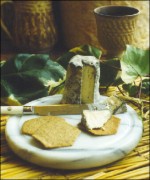
Issue No. 6 - April/May 1999 |
|
|
 |
Welcome once again to 'The Teddington Cheese Wire'. In this issue
we will be featuring the fabulous goats' milk cheese, 'Chabichou de
Poitou' from the Loire in France and using it in our recipe 'Tian Provençal'.
We will also turn our attention to British cheese and ask what the
future holds.

Above from left to right: Sannen, Anglo-Nubian
and Toggenburg breeds of goat.
A popular idea over the past two months has been the 'Cheese of the
Week'. Almost every day customers tell us about their favourite cheeses
or those they have tried whilst away on holiday. It was frustrating
for us to imagine these cheeses and not be able to taste them and equally
frustrating for customers when told that we could not add them to our
range. It is not possible to keep more than a hundred or so different
cheeses in tip-top condition at any one time and, with several thousand
cheeses available, we can only stock a fraction of these.
The 'Cheese of the Week' has allowed us to try a
different new cheese each week. We can read about and look at pictures
of cheese but it is not until we actually see, feel, smell and then
taste a cheese that we get to understand and remember it. Opening the
cheese of the week for the first time is always an exciting occasion
for the cheesemongers at The Teddington Cheese. We each give our opinion
and wonder if it will win over the hearts and taste-buds of our customers.
One of the greatest pleasures is then presenting the cheese and hearing
our customers comments. Of course, bringing back the pleasant memories
of a customers holiday or the happiness of a favourite cheese, even
if only for a week, make it extra special.
|
|
Cheeses of the Week
during the last 8 weeks
La Pierre Belle - soft unpasteurised
goats' milk cheese from France; Berkswell
- firm unpasteurised ewes' milk cheese from Warwickshire; Mahon
- semi-soft pasteurised cows' milk cheese from Mallorca, Spain;
Glenogra - semi-soft un-pasteurised cows' milk cheese
from Ireland; Dunsyre
Blue - firm unpasteurised cows' milk blue from Lanarkshire, Scotland;
Hereford Hop - firm pasteurised cows' milk cheese
coated in hops; Tomme d'Abondance - unpasteurised
cows' milk cheese from the Haute-Savoie; Manchego
- award winning unpasteurised ewes' milk cheese from Spain.
|
|
'A CLOVE OF CHEESE PLEASE'
"I'd like a clove of cheese, a long hundred of
eggs and a bag of biscuits"
or
"I'd like 8lbs of cheese, 10 dozen eggs and 102lbs
of biscuits"
or
"I'd like 3.6288kg of cheese, 120 eggs and 46.2672kg
of biscuits"
Although we have to buy, label and weigh our
cheese by the kilogram you can rest assured that we will always understand
you. (Measurements taken from the 'Sunlight Year Book' guide to weights
and measures 1899.
|
|

EGGS EGGS
Large free-range farm eggs
When they first moved into Greenacres Farm in the
mid 80's, Kevin and Alison relied on the production of free range
eggs from their flock of hens in order to make a living. Nowadays,
although better known for their delicious goats cheese, the Blunts
still sell their fresh free range eggs. Unlike commercially produced
eggs, these do not have to conform to a unified shade of shell and
yolk and each egg is a real treat.
STOP PRESS
Several months after the release of this edition
of the Cheese Wire Kevin and Alison Blunt sold off their flocks of
hens in order to use their land to accomodate more goats. We will
let you know when we have found a new supplier of truly free-range
eggs.
|
|
Competition Winner:
The winner of the caption competition in issue
5 was Mrs Cheshire of Rednal, Birmingham with: 'I always hand wash
my delicate things'.

Thank you to everyone who entered our competition.
We had so many excellent entries and they have kept us chortling
for hours. We're sorry that we can only afford one prize.
|
|
|
- Cheese focus -
Chabichou du Poitou
Poitou, France

The 'Saracens' were a people of Arab descent, who
originally settled in the south of Spain but then gradually moved
north into France. By the 8th century they had reached Poitiers in
the Loire valley, but it was at this point that they were finally
repelled. When they were expelled from France, they left behind not
only goats, but also recipes for making cheese from their milk. The
Loire valley became the starting point in the history of goats' milk
cheese in France, and remains the most important area of production.
Villages on either side of the Loire river produce
goats' milk cheeses of different sizes and shapes. These cheeses
have delicately varied flavours and include five AOC's - a classification
given to cheeses in the same way as wines. In the eastern part of
the area there is the small drum-shaped Crottin de Chavignol; to
the west the log-shaped Saint Maure de Tourraine; to the north of
the central region the round-shaped Selles-sur-Cher; to the south
the pyramid-shaped Valençay and to the south-west the cone-shaped
Chabichou de Poitou. Poitou is the most important goat breading region
in France. The Chabichou du Poitou takes its name from the local
dialect word for 'goat' derived from the Arabic 'chebli'.
The cheese is emphatically goaty in flavour and
aroma. The paste is firm and white and the rind is pale blue-grey
in colour. There are many industrial versions of this cheese but
ours is made using traditional farmhouse methods.
Each cheese is approximately 6cm high, is cone-shaped
with a 4cm base and a 3cm top, weighs 100 to 150grammes and has a
minimum fat content of 45%. Cheeses are available throughout the
year and the best are made from spring to autumn. Chabichou can be
eaten fresh or matured for four weeks in a cool and humid cellar,
during which time the blue-grey rind develops.
Chabichou can be accompanied with Sancerre, Pouilly
Fumé or the red wines of the Loire. The cheese is excellent both
on the cheese-board and for cooking; it is fabulous when sliced and
grilled.
|
|

Ingredients
1 Chabichou de Poitou
4 courgettes
4 tomatoes
1 garlic
thyme (1tbsp)
oregano (1tsp)
virgin olive oil (4 tbsp)
boiled rice (200g)
salt & pepper
back
to top
|
- Recipe -
Tian Provençal
serve as a starter for four
1.
Cut the tomatoes, courgettes and cheese into
1cm thick discs
2.
Peel the garlic clove
3. Crush
the garlic into the olive oil and use to grease the serving dish
4. Spread
out the rice on both sides of the serving dish
5. Alternately
place the tomato, courgette and cheese into the centre of the dish
6. Sprinkle
over the thyme, oregano, salt and pepper
7. Bake
in a medium oven (180ºC) for 35minutes and serve whilst warm
|
|
|
|
OPENING SOON
The Kew Cheese
at 277 Sandycombe Road, Kew

At the moment we are undertaking extensive renovation
work on an old property on Sandycombe Road in Kew. We are planning to
open this second shop in July with the same fine cheeses and produce
that we sell at the Teddington Cheese. We will also be extending our
wine range and introducing a selection of cheese and wine accessories.
|
|
|
- Cheese Tips -
Can you eat the cheese rinds?
We are often asked whether the rinds
of cheese can be eaten. The answer depends upon where and for how long
the cheese has been matured and also how the cheese is made.
Stilton, Double Gloucester,
Gruyere: These
cheeses are matured for many months with their rinds open to the air.
Dust in the cheese store easily falls onto the cheeses. We do not recomend
eating the rinds of these types of cheese.
Brie, Camembert, Chanteraine:
Younger bloomy rind cheeses sit in the open,
maturing for shorter periods and in a clean environment. This type of
rind can be eaten.
Farm-house Cheddar,
Cheshire, Lancashire: Although these cheeses
are matured for many months and even years, they are protected by a
covering of cheese cloth. This cloth is stripped off just before cutting
for sale and the clean rind can be eaten. In days gone by babies would
have been given these hard cheese rinds upon which to 'teeth'.
Epoisses, Munster,
Langres: Washed rind cheeses tend to be pungent
in aroma, full in flavour and usually have sticky orange rinds. During
maturation these cheeses are washed in brine and a multitude of wines
or spirits. They are kept in a clean environment and the rinds can be
eaten.
Valençay, Crottins,
Chabichou: Goats' milk cheeses tend to develop
the most fabulous and colourful rinds. Since they are relatively young
and generally kept in a clean environment the rinds can be eaten.
Of course, whether to eat a rind or not
is down to personal choice. Many of our customers remove all their rinds
whilst others are convinced that the rinds can be the best part of a
cheese.
|
|
JOB VACANCIES
Assistant Cheesemonger at
The Teddington Cheese.
First and foremost s/he must have a general enthusiasm
for food and a specific liking for cheese. Initially two days a week
will be required, one of which will be Saturday. Applicants must be
able to work extra time during the Christmas period. Please telephone
Orlando on 020 8977 6868.
Summer work in Normandy, France
at La Maison du Vert. Two people to help run
a small but busy vegetarian hotel restaurant during the summer. The
work will involve serving and clearing away breakfasts, room cleaning,
serving lunch and dinner, welcoming guests and helping in the gardens.
We offer a 35/40 hour week, 25FFr
per hour, own room, laundry service, use of van on day off, all meals
and drinks included. We would like persons to have a current clean driving
license and speak a little French, enjoy their own company as this is
rural France and enjoy meeting folk.
If interested please contact Jill
or Colin Kirk at La Maison du Vert, Ticheville, F 61120. Tel 00 33 233
369 584 or e-mail colin kirk@wanadoo.fr www.perso.wanadoo
.fr/lamaisonduvert
STOP PRESS
Job vacancy at La Maison du Vert has now been filled.
Positions at The Teddington Cheese and The Kew Cheese occasionally arise.
Please contact 020 8940 1944 for latest vacancies.
|
|
|
What does the future hold for
traditional British cheese?
|
In our last edition of the Teddington
Cheese Wire we examined an article written 100 years ago on the threat
of foreign imports to the future of British Cheese. In fact the threat
came from within the UK itself with the lack of government effort after
the second world war to reestablish farmhouse production of British
Cheese. Only over the last twenty years has traditional British cheese-making
started to recover. It is the intention of this article to forecast
the potential and the threats to British cheese-making over the next
100 years.
The threat from foreign imports:
Cheese has been made throughout Europe for hundreds of years and many
countries and regions have developed their own types of cheese. The
geography, flora and fauna and the influence of man (e.g. the agricultural
teaching of farmers by monks) have all dictated the type of cheese-making.
I have often heard people saying that British cheese is the best in
the world - indeed the British do make superb cheese but so do the French,
Swiss etc. all with their own character. We will always have foreign
cheese imports and so we should.
Whilst I believe that the quality and sales of traditional British cheese
will withstand foreign imports, the success of our own exports is limited.
I took a trip around a dozen of the best cheesemongers in Paris and
could only find old greying Stilton and block factory cheddar. Our fellow
Europeans know little of real British cheese and I believe that from
our present position we can only move forwards.
Lack of organisation within the farmhouse
cheese industry.
In Britain we have the territorial cheeses, for example, Stilton, Cheddar,
Lancashire, and Cheshire. Although Stilton is the only legally protected
cheese I am sure they will all survive the next 100 years. However,
the up and coming cheeses of today such as Wigmore, Golden Cross and
Berkswell will disappear when the present producers cease trading. Possibly,
one or two will survive through their sons and daughters but the vast
majority will not.
We need to learn from the success of the French and the Italians. They
have AOC's and DOC's, regulations which dictate how, when and where
a cheese can be made and stipulate that no other cheese may be called
by the same name. Any number of farms can make a particular cheese provided
that they satisfy all the rules governing the AOC or DOC requirements.
In fact, in Italy especially, these groups of producers have pooled
their resources to create a more powerful marketing cooperative to help
promote their cheese in home and export markets, and have been very
successful. In this way successful cheese-makers could perhaps encourage
other individuals to start making the same cheese nearby. Of course
this would be a courageous step since no-one wants to give away their
secrets and loose market share. However, I believe that the long term
benefits and the future of British cheese depends on this sharing.
Threats from our own Government's
legislation.
If an individual decides to make cheese it is no longer a simple matter
of buying a small farm and a herd a cattle. A milk quota first has to
be purchased, which can cost almost as much as the land, and makes the
venture unviable, even before a single cow has been milked. In this
climate, very few new cheese-makers are likely to emerge.
Cheese-makers are fearful of the Government's
plans for a new food agency. It is envisaged that all food producers
and retailers will be levied a charge and the amount will bear little
resemblance to their ability to pay. In the same way that business rates
have strangled small independent high street shops the small farm producers
fear they will be asked to carry a heavy and crippling financial burden.
In general I heartily support the work
of the Environmental Health Officers and feel that some pressure put
on cheese-makers can only help to keep hygiene and good working practices
at the front of their minds, and ensure a healthy future for the industry.
However, recently some Health Officers have been involved in controversial
cases regarding the blanket destruction of cheese following reported
food poisoning incidents. Each time they appear to have been illogical
and have threatened the lively-hood of the cheese-maker. It is these
actions by over zealous Environmental Health Officers that cheese-makers
fear most.
Conclusion.
It amazes me how farmhouse cheese-makers summon up the energy to go
out 365 days a year to milk and tend their animals and then slave for
hours in their small dairies making cheese. On top of this they have
to mature, pack, sell and dispatch their cheese. Cheese-makers tell
me that the satisfaction of producing their own cheese and seeing it
find its way to people who appreciate it makes up for all the hard work
and the small financial rewards.
I believe the major threat to real British
cheese is, without doubt, that of the Health Department's quest for
an antiseptic and cotton-wool coated world. I hope that the general
public will soon recognize that life's richness can be threatened by
having to boil your lettuce, buy straight bananas produced for easier
packing and egg yolks dyed to 'shade 3 harvest yellow'. I believe that
when people decide that we have gone far enough down the route of sterility
then the Government will have to stop and listen. Of course, it may
be too late for some cheese-makers, but I hope that the change will
come in time for most. I believe the individuals in this small industry
are strong enough to survive.
Tony Parkes, Cheesemonger
|
|
| BACK TO TOP |
|
|
| All
articles © www.teddingtoncheese.co.uk |
|







